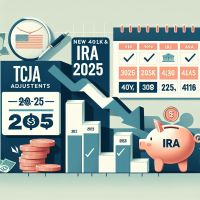The Setting Every Community Up for Retirement Enhancement Act of 2019 (SECURE Act) changed the rules for taking distributions from retirement accounts inherited after 2019. The so-called 10-year rule generally requires inherited accounts to be emptied within 10 years of the original owner’s death, with some exceptions. Where an exception applies, the entire account must generally be emptied within 10 years of the beneficiary’s death or within 10 years after a minor child beneficiary reaches age 21. This reduces the ability of most beneficiaries to spread out, or “stretch,” distributions from an inherited defined contribution plan or an IRA.
In 2022, the IRS issued proposed regulations that interpreted the revised required minimum distribution (RMD) rules. Final regulations have now been issued and are generally applicable starting in 2025. They basically adopt the proposed regulations, while reflecting some changes made by the SECURE 2.0 Act of 2022 and including certain changes in response to comments received on the proposed regulations. Under these regulations, some beneficiaries could be subject to annual required distributions as well as a full distribution at the end of a 10-year period. Account owners and their beneficiaries may want to familiarize themselves with these changes and how they might be affected by them.
RMD basics
If you own an individual retirement account (IRA) or participate in a retirement plan like a 401(k), you generally must start taking RMDs for the year you reach your RMD age. RMD age is 70½ (if born before July 1, 1949), 72 (if born July 1, 1949, through 1950), 73 (if born in 1951 to 1959), or 75 (if born in 1960 or later). If you are still working for the employer that maintains the retirement plan, you may be able to wait until the year you retire to start RMDs from that account. Failing to take an RMD can be costly: a 25% penalty tax (50% prior to 2023) generally applies to the extent an RMD is not made.
The required beginning date (RBD) for the first year you are required to take a lifetime distribution is no later than April 1 of the next year. After your first distribution, annual distributions must be taken by the end of each year. (Note that if you wait until April 1 to take your first-year distribution, you would have to take two distributions for that year: one by April 1 and the other by December 31.)
Lifetime distributions are not required from Roth accounts and, as a result, Roth account owners are always treated as dying before their RBD. Prior to 2024, these two special rules for Roth accounts applied to Roth IRAs, but not to Roth employer retirement plans.
When you die, the RMD rules also govern how quickly your retirement plan or IRA will need to be distributed to your beneficiaries. The rules are largely based on two factors: (1) the individuals you select as beneficiaries of your retirement plan, and (2) whether you pass away before or on or after your RBD.
Who is subject to the 10-year rule?
The SECURE Act still allows certain beneficiaries to “stretch” distributions, at least to some extent. These eligible designated beneficiaries (EDBs) include your surviving spouse, your minor children, any individual not more than 10 years younger than you, and certain disabled or chronically ill individuals. Generally, EDBs are able to take annual required distributions based on remaining life expectancy. However, once an EDB dies, or once a minor child EDB reaches age 21, any remaining funds must be distributed within 10 years.
Significantly, though, the SECURE Act requires that if your designated beneficiary is not an EDB, the entire account must be fully distributed within 10 years after your death.
What if your designated beneficiary is not an EDB?
If you die before your RBD, no distributions are required during the first nine years after your death, but the entire account must be distributed in the 10th year.
If you die on or after your RBD, annual distributions based on remaining life expectancy are required in the first nine years after the year of your death, then the remainder of the account must be distributed in the 10th year. Annual distributions after your death will be based on the greater of (a) what would have been your remaining life expectancy or (b) the beneficiary’s remaining life expectancy.
What if your beneficiary is a nonspouse EDB?
After your death, annual distributions will be required based on remaining life expectancy. If you die before your RBD, required annual distributions will be based on the EDB’s remaining life expectancy. If you die on or after your RBD, annual distributions after your death will be based on the greater of (a) what would have been your remaining life expectancy or (b) the beneficiary’s remaining life expectancy.
After your beneficiary dies or your beneficiary who is your minor child turns age 21, annual distributions based on remaining life expectancy must continue during the first nine years after the year of such an event. The entire account must be fully distributed in the 10th year.
What if your designated beneficiary is your spouse?
There are many special rules if your spouse is your designated beneficiary. The 10-year rule generally has no effect until after the death of your spouse, or possibly until after the death of your spouse’s designated beneficiary.
What life expectancy is used to determine RMDs after you die?
Annual required distributions based on life expectancy are generally calculated each year by dividing the account balance as of December 31 of the previous year by the applicable denominator for the current year (but the RMD will never exceed the entire account balance on the date of the distribution).
When your life expectancy is used, the applicable denominator is your life expectancy in the calendar year of your death, reduced by one for each subsequent year. When the nonspouse beneficiary’s life expectancy is used, the applicable denominator is that beneficiary’s life expectancy in the year following the calendar year of your death, reduced by one for each subsequent year. (Note that if the applicable denominator is reduced to zero in any year using this “subtract one” method, the entire account would need to be distributed.) And at the end of the appropriate 10-year period, any remaining balance must be distributed.
Relief for certain RMDs from inherited retirement accounts for 2024
The IRS has announced that it will not assert the penalty tax in certain circumstances where individuals affected by the RMD changes failed to take annual distributions in 2024 during one of the 10-year periods. (Similar relief was previously provided for 2021, 2022, and 2023.) For example, relief may be available if the IRA owner or employee died in 2020, 2021, 2022, or 2023 and on or after their RBD and the designated beneficiary who is not an EDB did not take annual distributions for 2021, 2022, 2023, or 2024 as required (during the 10-year period following the IRA owner’s or employee’s death). Relief might also be available if an EDB died in 2020, 2021, 2022, or 2023 and annual distributions were not taken in 2021, 2022, 2023, or 2024 as required (during the 10-year period following the EDB’s death).
The rules relating to required minimum distributions are complicated, and the consequences of making a mistake can be severe. Talk to a tax professional to understand how the rules, and the new regulations, apply to your individual situation.




